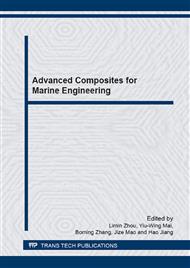[1]
J.C. Remmers, Discontinuities in materials and structures: a unifying computational approach, PhD Thesis, Delft University of Technology, (2008).
Google Scholar
[2]
A. Vlot, J.W. Gunnink, editors. Fiber metal laminates - an introduction. Dordrecht, The Netherlands: Kluwer Academic Publisher; (2001).
Google Scholar
[3]
A. Vlot, Impact properties of fibre metal laminates. Compos. Eng. 3 (1993) 911–927.
Google Scholar
[4]
A. Vlot, Impact loading on fibre metal laminates. Int. J. Impact. Eng. 8 (1996) 291–307.
DOI: 10.1016/0734-743x(96)89050-6
Google Scholar
[5]
M.S.H. Fatt, C.F. Lin, D.M.R. Jr, D.A. Hopkins, Ballistic impact of GLARE fiber–metal laminates. Compos. Struct. 61 (2003) 73–88.
DOI: 10.1016/s0263-8223(03)00036-9
Google Scholar
[6]
G.S. Langdon, G.N. Nurick, W.J. Cantwell, The response of fibre metal laminate panels subjected to uniformly distributed blast loading. Eur. J. Mech. A/Solids. 27 (2008) 107–115.
DOI: 10.1016/j.euromechsol.2007.09.003
Google Scholar
[7]
G.H. Payeganeh, F.A. Ghasemi, K. Malekzadeh, Dynamic response of fiber–metal laminates (FMLs) subjected to low-velocity impact. Thin-Walled Struct. 48 (2010) 62–70.
DOI: 10.1016/j.tws.2009.07.005
Google Scholar
[8]
A.P. Christoforou, A. S Yigit, W.J. Cantwell, F.J. Yang, Impact response characterization in composite plates—experimental validation. Appl. Compos. Mater. 17 (2010) 463–472.
DOI: 10.1007/s10443-010-9140-4
Google Scholar
[9]
J. Fan, W.J. Cantwell, The low-velocity impact response of fiber–metal laminates. J. Reinf. Plast. Compos. 30 (2011) 26–35.
Google Scholar
[10]
G. Wu, J.M. Yang, H.T. Hahn, The impact properties and damage tolerance and of bi-directionally reinforced fiber metal laminates. J. Mater. Sci. 42 (2007) 948–57.
DOI: 10.1007/s10853-006-0014-y
Google Scholar
[11]
Y. Liu, B. Liaw, Effects of constituents and lay-up configuration on drop-weight tests of fiber–metal laminates. Appl. Compos. Mater. 17 (2010) 43–62.
DOI: 10.1007/s10443-009-9119-1
Google Scholar
[12]
S.H. Song, Y.S. Byun, T.W. Ku, W.J. Song, J. Kim, B. S Kang, Experimental and numerical investigation on impact performance of carbon reinforced aluminium laminates. J. Mater. Sci. Technol. 26 (2010) 327-332.
DOI: 10.1016/s1005-0302(10)60053-9
Google Scholar
[13]
H. Seo, J. Hundley, H.T. Hahn, J.M. Yang, Numerical simulation of glass-fiber-reinforced aluminium laminates with diverse impact damage. AIAA J. 48 (2010) 676-687.
DOI: 10.2514/1.45551
Google Scholar
[14]
M. Sadighi, T. Parnanen, R.C. Alderliesten, M Sayeaftabi, R Benedictus, Experimental and numerical investigation of metal type and thickness effects on the impact resistance of fiber-metal laminates. Appl. Composite Mater. 19 (2012) 545-559.
DOI: 10.1007/s10443-011-9235-6
Google Scholar
[15]
J. Fan, Z.W. Guan, W.J. Cantwell, Numerical modelling of perforation failure in fiber-metal laminates subjected to low velocity impact loading. Compos. Struct. 93 (2011) 2430-2436.
DOI: 10.1016/j.compstruct.2011.04.008
Google Scholar
[16]
G.R. Johnson, W.H. Cook, A constitutive model and data for metals subjected to large strains, high strain rates and high temperatures. In: Proceedings of the seventh international symposium on ballistics; 1983. The Hague, Netherland. p.541–547.
Google Scholar
[17]
G. Kay, Failure modeling of titanium–61–4V and 2024-T3 aluminum with the Johnson–Cook Material Model. In: US Department of Energy; (2002).
DOI: 10.2172/15006359
Google Scholar
[18]
D. Lesuer, Experimental investigations of material models for Ti–6AL4V and 2024-T3; 1999. U.S. Department of Energy.
Google Scholar
[19]
Z. Hashin, Failure criteria for unidirectional fiber composites. J. Appl. Mech. 47 (1980) 329–334.
Google Scholar
[20]
S.C. Tan, A progressive failure model for composite laminates containing opening[J]. J Compos Mater. 25 (1991) 556-577.
Google Scholar
[21]
A. Seyed Yaghoubi, B. Liaw, Thickness influence on ballistic impact behaviors of GLARE 5 fiber-metal laminated beams: Experimental and numerical studies. Compos. Struct. 94 (2012) 2585-2598.
DOI: 10.1016/j.compstruct.2012.03.004
Google Scholar
[22]
A. Seyed Yaghoubi, Y. Liu, B. Liaw, Low-velocity impact on Glare 5 fiber-metal laminates: influences of specimen thickness and impactor mass. J. Aerospace Eng. 25 (2012) 409-420.
DOI: 10.1061/(asce)as.1943-5525.0000134
Google Scholar


